Master Recipe from Gluten-Free ABin5
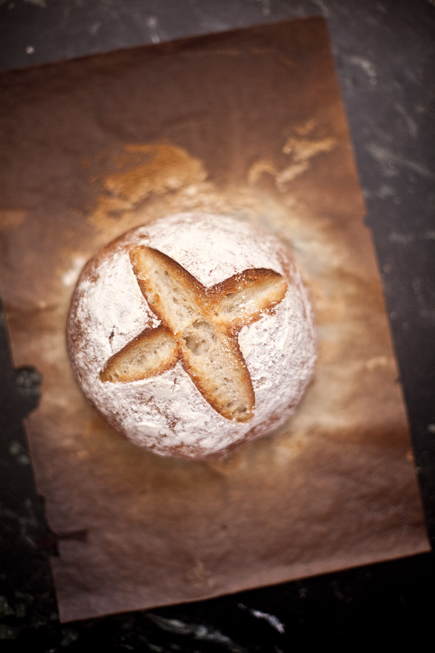
The idea for a gluten-free version of The New Artisan Bread in Five Minutes a Day started here on the website. People were writing in to say they loved the method, but couldn’t eat wheat. It set off a quest to develop recipes that fit this fast and easy method but used flours that were gluten-free. Gluten-free breads have appeared in all of the books since then, but they were just small chapters among a bunch of wheat filled recipes. It seemed unfair to the folks who couldn’t eat wheat to buy a book filled with recipes that didn’t suit their needs, so… a book just for them. Last week Gluten-Free Artisan Bread in Five Minutes a Day came out–here is its Master Recipe.
There’s been great feedback from the original gluten-free recipes, but what you see here is even further simplified. That meant developing two flour mixes that all our recipes are based on, so you just have to mix the flour once for many loaves. You just mix up a big batch of our Gluten-Free All-Purpose Flour Mix and/or our Whole-Grain Gluten-Free Flour mix and you’ll be able to quickly mix and bake all 90 gluten-free artisan bread recipes in our book. (Commercial flour mixes haven’t worked well for breads made from stored dough).
I also wanted to provide recipes that are mostly vegan (no eggs) and dairy free. Because eggs are a leavening ingredient, we do like the Master Recipe made with eggs for a lighter loaf. In fact, we find that the dough made with egg whites is the lightest of all the options. You can also use an egg substitute if you choose not to use eggs. And as always with the method, you save time by mixing a large batch and storing it in the refrigerator, pulling off dough to use as you need it.

The following recipe is the Master Recipe from GFABin5 made with egg whites, but you can make the same recipe with whole eggs, egg substitutes or without any eggs at all.
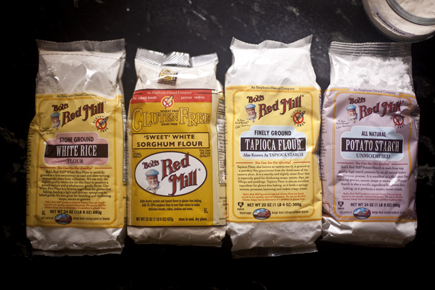
Gluten-Free Master Recipe from Gluten-Free Artisan Bread in Five Minutes a Day on page 64, and the egg variation can be found on page 73). For a video of this recipe’s steps that’ll open in a new window, click here):
6 1/2 cups (2 pounds 3 ounces / 990 grams) flour mixture #1 from the book, which is reprinted at this link. We tested all our recipes with Bob’s Red Mill unblended flours, not their gluten-free flour mixtures.
1 tablespoon Red Star Active Dry or Quick Rise yeast (not Red Star Platinum, which isn’t gluten-free)
1 to 1 1/2 tablespoons Kosher salt
2 tablespoons sugar or honey (we find that the gluten-free dough needs the sugar to brown nicely, although it is optional)
4 egg whites, plus enough warm water to equal 3 3/4 cups (*see picture below) – if you don’t want to use eggs, then just use 3 3/4 cups water.
To mix the dough:

*Put 4 egg whites in a large measuring cup, fill the cup with water until you have 3 3/4 cups liquid.
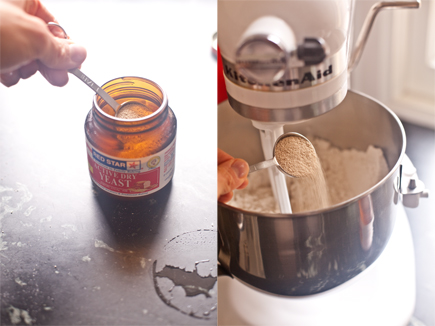
I suggest using a Stand Mixer with the paddle attachment for the smoothest dough and ease of mixing. You can still do the mixing in a bucket or bowl, as recommended in the past books, but it will take a bit more effort to get a really smooth dough.
In a stand mixer, fitted with the paddle attachment, add the yeast to the flour mix #1. The recipes were tested with both Active and Quick Rise yeast from Red Star and they work equally well in stored gluten-free dough. You can’t use their Platinum yeast, since it contains trace amounts of wheat.
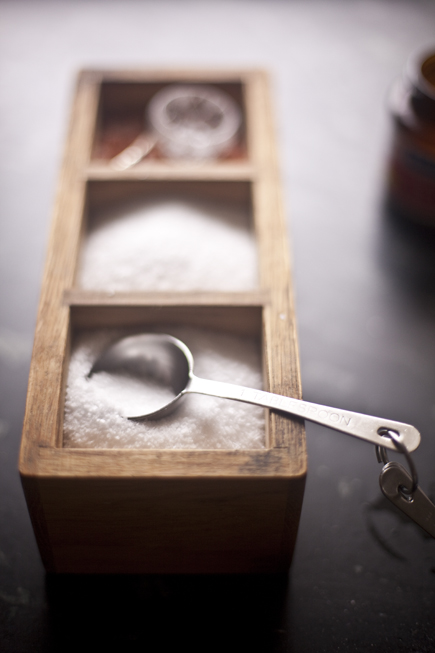
Add the Kosher salt and the sugar (if using) to the flour mix. You can add more or less salt, depending on your preference.
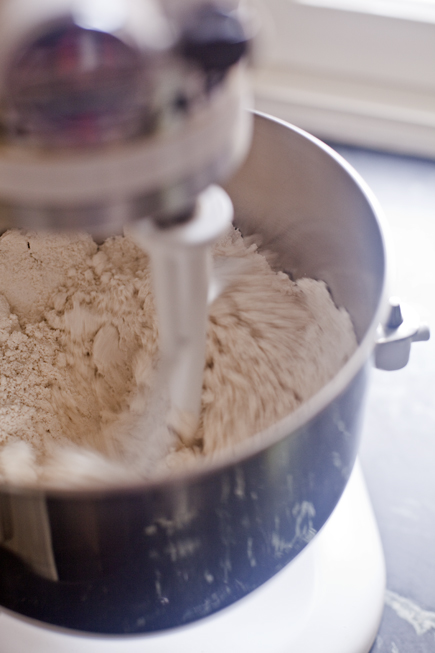
Blend all the dry ingredients for a few seconds.
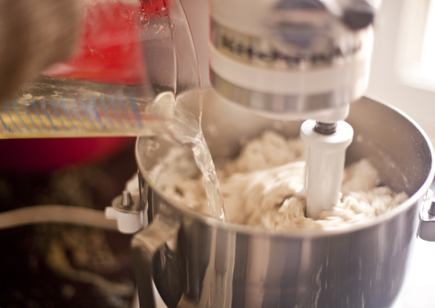
While the mixer is on low speed, slowly add all the liquid.
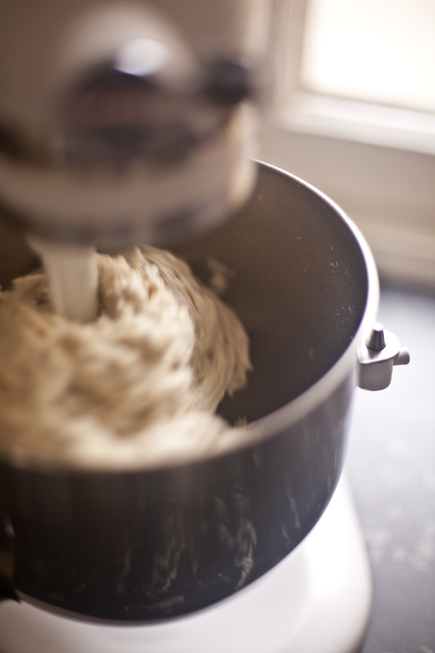
Once all of the liquid is added to the mixer, turn it up to medium-high speed and let it blend for about 1 minute.
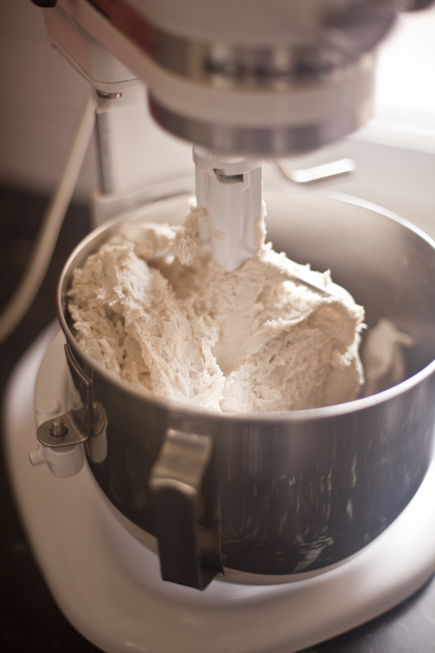
The dough will look and feel like soft biscuit dough.

Transfer the dough to a 4+ quart Food-Storage Container. The dough will rise some, but don’t expect it to double in size.
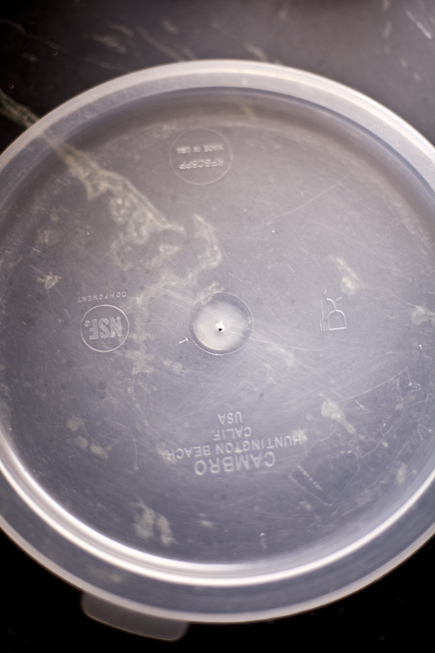
Cover the container, but it shouldn’t be airtight. You may want to poke a very small hole in the lid (you can see it in the exact center of the above lid) to allow the gas from the yeast to escape. If you don’t poke a hole…
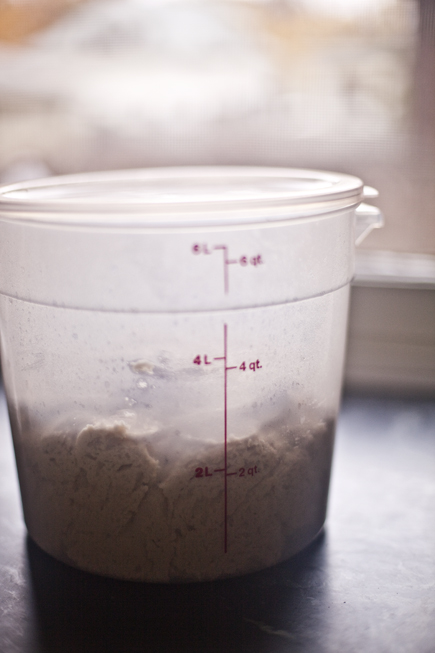
…then you will want to place the lid on the container, but don’t snap it all the way shut (see above photo). Don’t allow too much air to get into the bucket or the dough may dry out.
Allow the dough to sit at room temperature for 2 hours. If your kitchen is cool, it may take 2 1/2 to 3 hours. You can use the dough after the initial rise or refrigerate the dough for about 5 days (10 if you don’t use eggs).
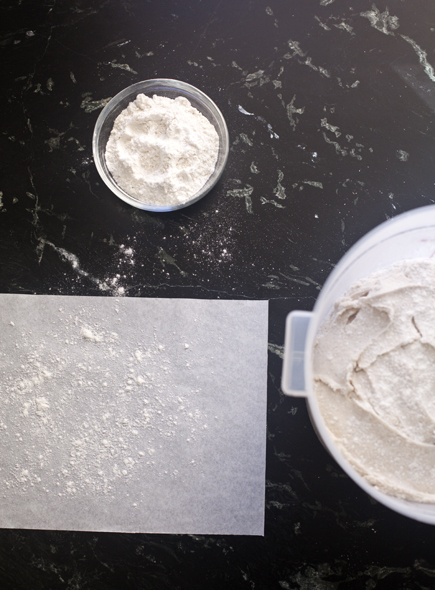
When you are ready to bake, sprinkle some GF flour on a piece of parchment. Dust the surface of the dough with more flour.
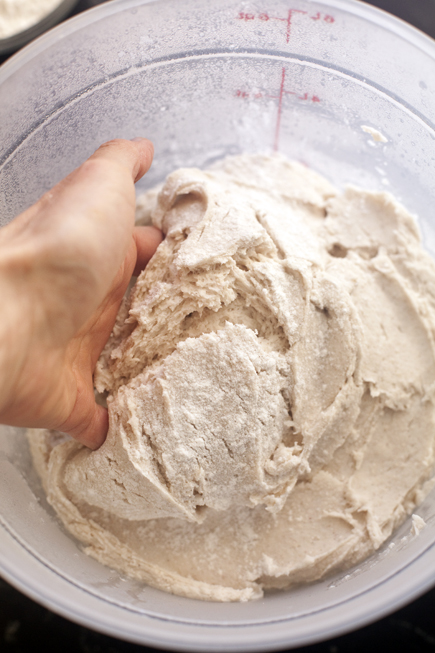
Scoop up a 1-pound piece of dough. Store the rest of the dough in the fridge for up to 5 days if using egg whites, or 10 days if you only used water. That’s where our method saves you time–all your subsequent loaves are made from pre-mixed, stored dough that will develop sourdough flavors as it ages.

Unlike wheat dough, this will not have any stretch when you lift it out, it will just break off.
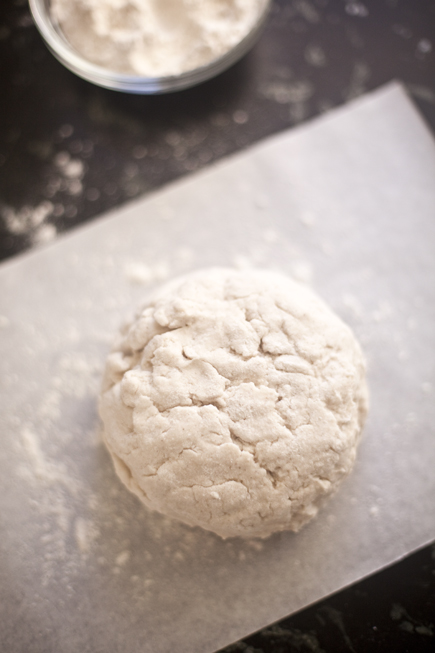
Place the dough on the parchment and shape it into a ball. It may not be smooth at this point.
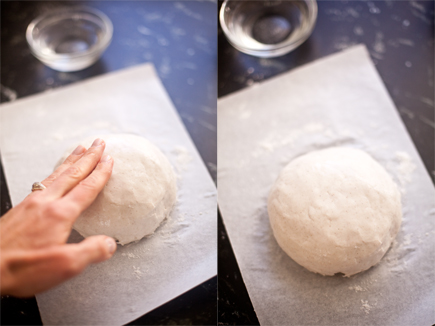
Using wet fingers, smooth out the surface of the dough. Creating a smooth surface also seems to help trap the gas from the yeast and improve the rise of the bread.
Cover loosely with plastic and allow to rise for about an hour. If you are using fresh dough, then just 30 minutes.
Preheat oven with a Baking Stone to 450°F. It is very important that your oven be hot enough, so use an oven thermometer to check the actual temperature. If you are using a thick Baking Stone, this can take 45 minutes or longer. Put a broiler tray on the bottom of the oven, which will be used to catch water to create steam in your oven.
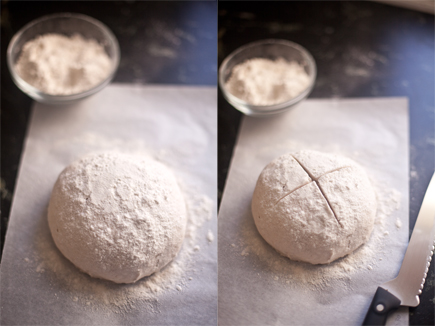
Once the dough is ready (it may not rise much while resting), dust it with more flour and slash the top with a serrated knife.
Slide the loaf onto the preheated baking stone, add 1 cup water to broiler tray to create steam and quickly close the door.

Bake the loaf for about 45 minutes or until nicely browned.

Allow the loaf to cool to room temperature before cutting into it. The gluten-free artisan bread will be quite gummy if you cut into it before it is totally cooled. Using a sharp serrated Bread Knife is the best for cutting this loaf.
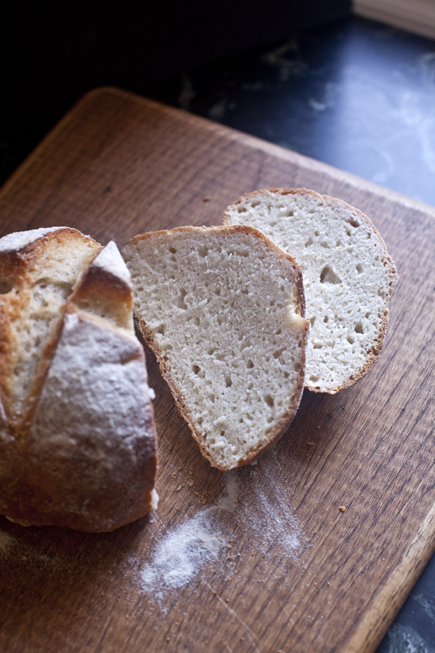
If you don’t finish the loaf in one or two days, wrap it well and freeze it for another time.
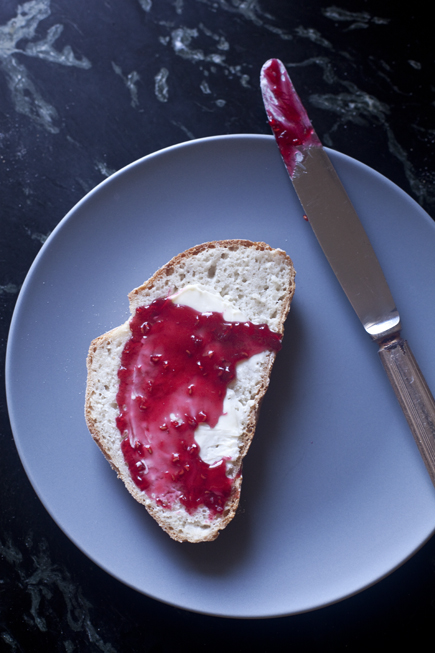
This gluten-free artisan bread also makes wonderful toast the next morning, and you can use up the remaining dough over the next 5 days (if you used egg whites), or 10 days (if you only used water).
See also our Gluten-Free Frequently-Asked Questions.
Note: BreadIn5.com is reader supported. When you buy through links on the site, BreadIn5 LLC earns commissions.
I pre-ordered your book as soon as I heard about it, and I was excited to get my copy last week! I have a quick question though, are there any substitutions for the rice flour or the potato starch? I try not to use rice flour or potato starch because they are nutritionally pretty pointless, and you list a lot of really great gluten free flours in the front of the book, but then only really go on to use them as texture agents rather than as the bread itself. I would much rather use almond, millet, quinoa flour, etc. if I could, but it seems like all the breads include rice and potato as the base.
Check out my answer to your question at https://artisanbreadinfive.com/2014/10/20/how-do-i-get-more-whole-grains-into-my-gluten-free-breads
Keep in mind that if you make the brown rice swap, you’ll be at 75% whole-grain just with Mixture #1. Mixture #2 is 100% whole-grain in the first place.
Thanks so much!
can you use a food processor to mix the dough? I do not have a stand mixer. Thanks
Sure, but it has to be large enough. Use the dough attachment, and you may have to do it in shifts.
Thanks Jeff. Appreciate your prompt reply.
Tnx for the great book. I am not celiac, but wheat and potato allergic, so I appreciate the sub info!
Thank you, thank you, in advance. I got your original artisan bread book several years ago and loved it. Then I developed a gluten sensitivity. After trying all the gluten free breads that were available to me, I ended up just giving up bread because they were all pretty terrible. The best of them couldn’t be eaten unless toasted. Then I went to Ireland and found that there were good gluten free breads in almost every restaurant and hotel. I have been rethinking the whole thing and decided that I would try making my own. But where to start? I immediately thought about the two of you and had planned to ask for some advice. I logged onto the website and low and behold, you’ve already done it. So thank you in advance. I’ve printed out the Master Recipe and am going to give it a go this weekend.
Terrific!
Hi there…. I tried the master recipe from the gluten free book (pg 64) and it was SO gummy. I followed the recipe exactly, weighed my ingredients, etc. On my second attempt I left the dough to rest extra long as suggested in your book. When I came to the website to see if there were any suggestions, I noticed that this recipe has egg whites, which the master recipe in the book does not. Is there perhaps an omission in the book?
I made the 100% Whole Grain Loaf (pg 102) and it was fantastic. Worth the price of the book alone, but I’d really like to get the white breads to work.
Today I tried the Oatmeal Maple Bread (pg 146) and it is also a little gummy, though not as bad as the Master Recipe. I wonder if there’s something wrong with the all purpose blend? Any suggestions?
First off, I just want to be sure you used the same flours as what we tested with. Did you use Bob’s Red Mill flours for everything? That’s what we tested with, and we found that the recipes are sensitive to even slight changes in ingredients, so let’s figure that out first.
We’ve updated the post to reflect that the egg variation IS in the book (on page 73). Some people have found that to be a lighter result, although I don’t think it’s required to get a decent loaf. So let’s check on your ingredients first.
Glad you liked the 100% whole-grain loaf, which really answers the concern that many have voiced about transitioning to GF–that much of the offerings out there are based on refined flours etc.
Yes, all my flours were Bob’s Red Mill. The only other thing I was thinking might contribute to my gummy loaves was that I live at about 4800 feet. Could that be the problem? I don’t have problems with other bread recipes due to altitude. I’ve been baking bread for years.
I was thinking maybe the white rice flour is the problem…most gluten free breads I make use brown rice. I don’t know. I’m stumped. The oatmeal maple bread was definitely an improvement, but still gummy.
We have minimal experience baking this stuff at altitude but have assumed that the usual tweaks might apply, see the FAQs tab above and click on “High-altitude baking: How do I adjust the recipes for high-altitude?” I’m hoping this might be the explanation, though I can’t explain the differences you’re seeing between the different recipes.
You said you were an experienced bread-baker, but is this your first foray into the world of GF breads?
No, this isn’t my first try with GF bread. I have had great success with a honey oatmeal bread that I found online plus other breads from America’s Test Kitchen and other GF Bread books. I think next time I’ll try adding a little more flour as suggested in your book and I’m definitely going to try adding the eggs as every GF bread I’ve made successfully includes eggs. I may also try a blend with brown rice flour instead of white rice flour. I just hate to have to try too many different things as the ingredients are expensive! Thanks for the input, hopefully I can find a recipe that works.
The eggs will probably do it for you– we struggled with whether to default to the egg version or not; some people who don’t eat wheat also report other food sensitivities and eggs are high on that list. Glad they don’t bother you!
Thank you for your new book. I was happily using your first book for years until I had to give up wheat due to an allergy. As soon as I heard about your gluten-free book, I pre-ordered it and have been enjoying trying out the recipes for the last 2 weeks. The basic recipe has a wonderful texture and the flavor is good but a little bland for my tastes. (I’m not a white bread kind of person.) I can see how it is going to be useful though for all of the variations in the book. I tried the 50% whole grain bread and liked that much better since I tend to like the flavor of whole grains. I was happily surprised that it still had a wonderful texture and think I have found my everyday go to mixture. 🙂 I have a substitution question about the pizza dough. Unfortunately I’m allergic to corn as well as wheat so I can’t use the cornmeal in that recipe. What would be a good substitution? I’m thinking maybe a coarse oat flour, or maybe teff or sorghum (my favorite gf flour). What do you think would be best to try? Thanks!
Glad you’re enjoying the 50/50, that would probably be my go-to as well, if I were GF-only. My guess is that since the pizza dough doesn’t have to support a high rise, it’ll be tolerant of adding in coarse oat or other GF flour as you suggest. But the hydration may change– just be ready to adapt to it. And this might take a lot of experimentation– which is exactly what we found in developing this book. You change one thing, sometimes just a little– and everything changes a lot!
If we only take out a pound of dough, what are we doing with the rest?
The key to our method is that you store the remaining dough in the fridge and use it up, baking as often as you like till it’s gone–that’s the time-savings; you don’t have to mix every time you want fresh bread. I’ve clarified the language above so that’s clearer. There’s much more on this in the book (https://amzn.to/1msOBmY).
Great recipe…. I cannot find sorghum flour in Spain, Any advice about agood sustitutions?. Many thanks!!!
I’ve just adjusted the Mixture #1 post so there’s a link at the bottom to the “Substitutions” FAQ page. You can take a look at the other two as well.
Thank you very much!!!, I can find out flour!!!
Words don’t often fail me; ask anyone who knows me. When trying to summarize my appreciation for your gluten free bread baking however, I’m struggling. Put simply, your efforts will change the lives of countless people who have been and will be deprived of the pleasures of sweet and savory baked options. I am convinced of this. Thank you, thank you, thank you. Your science is brilliant, the ingredients are simple, and the instructions are clear. Best yet, the results are incredible. Please keep the recipes coming, and again, thank you!
Thank you so much Heather. By any chance, would you be willing to tell us which recipes from the new book that you’ve baked? By “new book,” I mean “Gluten-Free Artisan Bread in Five Minutes a Day,” which came out last month.
Hello Jeff, To date, I’ve made the baguettes, ciabatta, and the pizzas. All fabulous. I personally have found the addition of the egg whites does indeed create a slightly lighter textured end-product. I was looking forward to making the brioche yesterday, but found I was out of eggs. Hopefully tomorrow… the pecans are sitting on the counter crying to be wrapped in sweet, rich dough and caramel! 🙂
Fantastic Heather!
I bake your regular bread all the time and this is my first time gluten-free baking. My loaf came out super-crusty (AKA hard as a rock on the outside). Is this typical? I wanted to serve it with dinner in a day for a friend who I cannot have gluten, but I’m afraid the loaf won’t even be able to be cut by then. Did I add too little water? Bake too long?
Do you have any of the books? Which exact recipe are you using, and did you make any substitutions at all? We tested with Bob’s Red Mill products, if you used something else might get different results. Did you check oven temp with something like https://ow.ly/8CVPU?
Shouldn’t be a super-hard crust, though in this post we are going for the artisan style– a crisp crust, nothing like store-bought bread. If you’re looking for soft crust, could paint with oil or butter before baking.
Did you cut into it yet? What’s the result?
It tastes good, and the texture is a bit dense, but not too bad. I used the recipe on the website and BRM flours. I did cut the water a bit short because it looked like it would be too runny. Would oil or honey work as a tenderizer? I used white sugar.
Ah– you really can’t cut the water early like that. This dough has to be very wet, or you probably won’t get the results we did. Oil’s fine and honey/sugar are pretty much equivalent as tenderizers.
I see that now. I have another batch baking now and it looks less dense than my previous one. I was treating it like your gluten recipes and I didn’t want to overdo the water. Thank you for your response!
I did not get much rise or oven spring, and the loaf seems quite dense. I used amaranth instead of sorghum, and brown rice instead of white. I used 3.75 cups + 2 TB water
I’m not sure how successful my mixing was; the dough seemed to just ride on the paddle. The dough seemed quite dense, but then I am used to wheat doughs. I wasn’t sure if it needed more hydration.
I baked my loaf in a lidded corning ware pot, Jim Lahey style, just as I have successfully done with regular bread.
I shaped and proofed right out of the fridge and the dough was still cool at the end of the proofing. Do you shape then proof the dough immediately after removing it from the fridge, or do you warm it up first?
I cut into the loaf while it was still warm and it seems to be a little gummy. I will check it again once it has thoroughly cooled. I also detect some unpleasant bitterness, though all the ingredients were fresh.
Thanks,
Dave
I forgot to mention that I used all Bob’s Redmill flours.
Dave
Some mixers behave this way (often, the 6.5 quart ones), and it sounds like as a result, you didn’t get a nice emulsification of the ingredients, which explains the density you got. You’ll have to keep pushing down the dough– or assist with some hand-mixing (actually, a lot of hand-mixing). The covered pot’s fine. We don’t warm up first, that’s not the problem either.
And most important: never cut into these breads when warm– they will be gummy.
Try spraying your mixer attachments with cooking spray this helps keep it form riding up…….and I am having the density issue also but in the book it says you can mix it well with the danish dough thing, maybe it should say you must use a stand mixer….
Well, that depends, not if your mixer is having the dough crawl up the paddle…
Thanks Jeff and Deb. I will try remixing the dough to see if that helps. The dough wasn’t climbing up the paddle, just riding around on it; should I have used the dough hook?
I still don’t know if I have to warm the dough from the fridge before shaping and proofing.
Thanks,
Dave
Dave, just use the paddle attachment the dough is really a wet dough, but spraying it with the cooking spray will keep it from riding up it…I used that trick when using my dough hook when making regular bread and also now making the gf version and the paddle attachment 🙂
Actually Dave I meant to say riding around on it, it should mix easier that way for you, give it a try…….it will stick to it and just go around in a big clump….is that what is happening? The spray should still work 🙂
In some mixers (in my 6.5 quart, for example), the dough hook’s a little better (no riding-around problem), but it takes forever to mix. In the 5.0 or 5.5 quarts, the paddle’s always better. You don’t have to warm the dough before shaping and proofing.
Thanks again Deb and Jeff.
I remixed (overmixed) a portion of the dough in my food processor and turned it into “plaster”. I rescued it by using a bench knife so spread it onto a silpat sheet and baking it into crackers in my microwave, about 5 to 6 minutes. They turned out pretty good, though an experienced drywaller would have done a neater job.. I have also made crackers from the initial mix by rolling it very thin between 2 silpat mats.
Great flexibility– keep working with it.
Hi, I tried the 50/50 blend and it was far too dense and did not have the rise I usually get….I was trying to make it without the eggs, only because organic eggs just keep adding to the cost of living this life 🙁
I also noted that in your gluten master recipe, you used 1 1/2 TBS of yeast for 6 1/2 cups of flour but in the 50/50 recipe only 1 TBS for 7 cups…..could that extra 1/2 TBS be the difference? Why less yeast in the gf recipes?
No question, the 50/50 without eggs is denser than say, the white loaf (Master) made with egg whites. It just may not be to your taste.
But– I’m just not seeing where you’re seeing 1 1/2 Tbs of yeast in any of these recipes. The GF recipes all call for 1 Tbs. ?? Our very first wheat book, in 2007, called for 1 1/2, but we found that it just wasn’t neccesary. Same for the GF recipes– all our books and web-recipes since 2009 have called for 1 Tbs for a 4 to 4.5 pound batch.
Well that expands the difference in the yeast, I was given an older version of the recipe obviously……but it worked beautifully…..Just interesting that all the recipes I se for gf break call for 1-2 TBS for a single loaf as opposed to an entire batch like we are making here…….Not trying to give you a hard time, really I am not, I just really want this to work for me 🙂
If you like it better with more yeast– go for it!
Hi there! This is the third of your books I’ve purchased and I think it will be my favorite! I just have one issue…my dough sinks in the fridge. Is that normal? I get a great first rise but then it collapses in the fridge. I’m not making any substitutions and this happens with both white and whole grain doughs. The resulting bread tastes good but seems pretty dense.
And thank you for this book, gluten free bread that is easy and tastes good is a god send to those of us who can’t eat wheat!
Our stuff does collapse in the fridge, yes. But you shouldn’t be getting dense results– see 53-56 in the book for tips on dealing with it– one thing to be extra careful– this stuff needs very thorough mixing.
Thanks for the answer, good to know it’s doing what it’s supposed to! I’m using a KitchenAid mixer with a paddle attachment so I’m pretty sure I’m getting it mixed well., and my oven temp is reading correctly. Maybe I’m over handling it, though I thought I was gentle. I’ll keep trying. I made the seeded whole grain loaf and it is very heavy…and yet delicious. So the process isn’t a complete wash. 🙂
A thought: Please consider setting up a separate Facebook page for Gluten Free Artisan Bread in 5. It will make networking and sharing tips much easier and will allow we advocates to share some of our pics. ALSO, we GFree’ers won’t be driven mad by the beautiful full gluten version recipes posted on your full Artisan Facebook page! Last but not least, we’re such a tight community, it will be easier to connect through gluten free search engines!
Thanks for the suggestion Heather. Short answer– maybe at some point in the future when we’re feeling a little less swamped. All of these channels have to be managed– and Zoe and I do all of this ourselves, so we’re limited. For now, the GF posts here on the website will be visited almost exclusively by GF folks–so we thought that would make a nice forum for like-minded bakers.
Hi Jeff and Zoe,
I just received the GF book and want to say thank you! I’m an experienced gf bread baker, but never quite 100% pleased with my past results so thought I would try your method. I baked my first boule from the master recipe yesterday, adding egg whites, and the loaf was truly delicious…and gone!
I admit to cheating some, as gf bakers we end up with so many flour mixes on hand since every book or magazine seems to use their own custom mix I’ve “defaulted” to Better Batter gf flour for breads. Their flour with your recipe and method was the most delicious bread I’ve made in the last three years. I’m hooked, after I bake off the dough in the fridge which was all made with Better Batter I will *even* try your flour mix for the next batch. That’s a whole lot of trust from one cynical gf baker, LOL.
Thank you from the bottom of my bread-loving heart!
Lastly, please do NOT set up a Facebook page for Gluten Free Artisan Bread in 5. Keeping all the comments/questions/advice in one place is definitely a time saver.
Hi Gayle,
Thank you so much for the note. I will have to try Better Batter for Bread. I have been hunting for a premixed GF flour to recommend and have come up short so far.
Enjoy! Zoë
My husband is allergic to corn so I would appreciate your help finding a substitute when making the boule.
Thanks so much!
Hi Marcia,
Here are some substitutions you can try: https://artisanbreadinfive.com/2014/10/19/substitutions-for-ingredients-in-our-gluten-free-recipes
Cheers, Zoë
Thank you for all the wonderful information! Unfortunately, since we cannot omit the cornstarch, I won’t be able to use the recipe. The original reason for asking about replacing the corn, was when it was used on the bottom to keep it from sticking.
If you can tolerate wheat products, you can use semolina which I prefer to cornmeal, or you can use wheat bran which I like on rustic breads.
Perfect! I’ve got Semolina flour so I’ll just use that! Thanks so much Dave.
Hi Marcia,
Sorry, I must have been confused, are you trying to substitute the corn in the GF recipes? The only recipes that require cornstarch are the brioche recipes, the boule doesn’t need any at all.
In your latest note, you mention just substituting the cornmeal under the loaf, in which case you can use parchment paper.
Thanks, Zoë
Hello again Zoe,
Thanks for responding again! Dave suggested Semolina flour and I’ve got that here. I’ll also try using parchment and see which one works best. I love options!!!
The link I selected in my email sent me here to ask my question. I hadn’t noticed the “corn starch” listed in the boule recipe, just the suggestion of putting corn meal on the bottom to keep it from sticking. I was surprised to read there was corn starch in it and thus my confusion. All is well now, thanks!
Sounds good Marcia,
The parchment is what I use, since it makes no mess in the oven and it is insurance that the bread will slide easily into the oven.
Cheers, Zoë
Just got your book….about to become a GF baker! What is the best way to store gluten free bread?
Hi Edna,
Enjoy all the bread! GF breads tend to stale pretty fast, so I suggest you freeze the bread if you don’t eat it all in one day.
Thanks, Zoë
Can I bake without a baking stone? Can I use a marble slab originally purchased as a rolling slab or will I ruin it by baking with it?
Hi Cynthia,
I think that marble is too fragile to use in the oven and have heard of them actually exploding (not sure if it is myth, but I’ve never tried it). You can use a baking sheet or any of these options: https://artisanbreadinfive.com/2010/08/24/pizza-stones-which-creates-the-best-crust
Thanks, Zoë
I used to use a few quarry tiles but didn’t like them because they were too light and moved too easily. Then I used fire brick (6 of them) which were a lot heavier. Then someone asked me if they were food safe and I didn’t know. So whatever you use, check it is food safe first. I would expect the baking stones to be food safe.
Thx, I have a cast iron that will work. Thx for the web link.. C-
Hi Cynthia,
I use my cast iron all the time with wonderful results.
Enjoy all the bread! Zoë
Did you do the nutritional calculations for this master recipe? I would be interested to know.
We don’t have those calculations, but you take a look at this page to do the calculations– go to the FAQs tab above, and click on “Nutrition content: How can I calculate it?”
I’m eagerly awaiting my book to arrive from Amazon but wonder if there’s a single loaf version of this. I have no room in my fridge right now! Thanks!
Just divide all ingredients by 4, and you’ll have a one-pound loaf. Some would say half, so you’d get the larger loaf.
Thanks Jeff. I appreciate the response!
I was unable to find sorghum flour at my market, however they had Bob’s Red Mill GF 1:1 baking flour (white rice flour,brown rice flour,potato starch, sorghum flour, tapioca flour, xanthan gum.)
I mixed up a batch of bread dough last night, following all instructions in the book (let it rise, refrigerated overnight.)
However, the dough is extremely soft–more like cake batter.
Do you have any experience with this mix? Should I be adding less water? Or some extra xanthan gum?
Any advice/suggestions greatly appreciated!
Yes– unfortunately, it doesn’t work. It was designed for cookies and such– not enough xanthan gum. You may be able to use this stuff if you add more xanthan but no idea how much. And it has to be whisked into the dry mix.
I have been making homemade bread for more than 3 decades. Having developed a gluten sensitivity, I wanted to try your GF Master Mix. I have your other Artisan bread cookbook and love it. So I set out today with Red Mill Gluten Free All Purpose Flour. The bag was 2#12oz and upon measuring I had approximately 2 cups left. After mixing in my stand mixer I had to add the other 2 cups as my dough resembled batter bread. I was also careful to measure exactly. Even after adding the rest of the flour my consistency is not like yours in the picture. I am going to follow through with this recipe but was hoping maybe you could illuminate my mistakes.
Thank you! 🙂
We have found that the commercial GF mixtures just don’t work in our recipes– we tested and tested, but weren’t happy. Our own gluten-free all-purpose flour mixture is here on this post, just follow the link from the ingredients list. We’ve never recommended using Red Mill Gluten-Free All Purpose, sorry for the confusion. You can try to salvage your batch by adding flour till it’s workable– a soft dough, but not like batter. No guarantee that it’ll work, because it contains garbanzo bean flour, which we found didn’t work well in our stored-dough recipes.
On thing– we definitely prefer the egg-white version here in this post. Much more in our GF book, on Amazon at https://amzn.to/1msOBmY
Hi,
How many loaves does this make?
Since I am the only one who eats gluten free in the house, can I bake all the loaves and freeze them?
4 one-pounders, and you can definitely freeze them. Wrap well!
My goodness! I’ve been baking bread almost since we were told to go completely gluten free nearly 4 years ago. I’ve had some successes and a few failures, but this bread is the biggest success of all! My two young daughters are declaring it to be the most delicious bread they’ve ever had. They’re too young to remember much about the taste of “normal” bread, but I’m not, and I have to agree with them! I can’t thank you enough for putting this recipe on your website so we could try before buying the gf book. I went straight over to Amazon to order the book after tasting the bread. We’re looking forward to trying all the GF recipes!
For the record, I am a baker of necessity, though I’ve learned to enjoy it (might as well). I’m not overly precise in the kitchen, and I used my trusty old cast iron skillet in place of a baking stone. The end result couldn’t have been any better. Thanks, and thanks again!
Hi Lacy,
Thank you so much for the wonderful note, we’re thrilled you and your family are enjoying the GF bread!
Cheers, Zoë
Saw the book review on glutenfreegourmand.blogspot.ca blog so I ordered the book, it’s beautiful, thank you! I used to be a serious bread baker before going GF so I’m very excited to return to my hobby!
I made up the Master Recipe dough yesterday (but sub’d 150g sourdough starter and reduced yeast to 1/8 tsp), and plan to bake a batard and some pretzels today.
One question, I notice a lot of online recipes that use psyllium have you whisk it into water for a minute or so until it gels, did you guys ever try this or find that it makes a difference?
Also was wondering if you think the ‘autolyse’ technique often used when baking wheat-based bread (mixing flour and water then waiting 30 min to add salt and yeast or levain) would be useful for GF bread?
Hi Mike,
This is a good quesiton. We don’t, in general, do an autolyse, due to our simplified “5 minute” process. As a result, I never tested it with the gluten-free doughs. Since the benefit of the autolyse is to improve the strength and stretch of the gluten in dough, I really don’t think that it will offer the same benefits to the GF dough.
To speed up the process we don’t hydrate the psyllium before mixing it in the dough. I did try it while testing the recipes and honestly did find enough improvement to require our readers to do the extra step. It certainly will not hurt the dough if you want to try it.
Thanks and enjoy! Zoë
I just mixed up dough today for my first attempt at baking your GF breads…used the basic Master white bread recipe. It is in the refrig and I am planning on baking a loaf tomorrow. Now, after reading all the comments I am thinking I should have added the egg whites as I don’t like a very dense bread. Is it possible to add them now and remix or is it too late?
No, unfortunately you’ll lose all your loft if you add it now and re-mix. Best bet: Bake it off, see what you think.
For the baguette buns. page 92 of your wonderful book, you preheat the baking stone but then place the baguette buns on a parchment lined baking sheet. The recipe says to slide the baking sheet into the oven, but makes no mention of the baking stone beyond the reference to preheating. Do we not bake the baguette buns on the baking stone? I’m confused. Thanks for your guidance.
We’re of several minds on this, and unfortuately, we let both of them into that recipe. I’ll explain:
If you have a heavy-duty aluminum, pro-style baking sheet, you can omit the stone altogether. When you’re baking on a sheet, the only function of the stone is to make amends for a cheap sheet, or an unevenly heating oven. So lots of people always bake with the stone, even if they’re using a sheet. Can’t hurt (except in the summer, when it seriously prolongs the preheating time)…
That recipe should have said you can omit the stone if desired.
We’re of several minds on this, and unfortuately, we let both of them into that recipe. I’ll explain:
If you have a heavy-duty aluminum, pro-style baking sheet, you can omit the stone altogether. When you’re baking on a sheet, the only function of the stone is to make amends for a cheap sheet, or an unevenly heating oven. So lots of people always bake with the stone, even if they’re using a sheet. Can’t hurt (except in the summer, when it seriously prolongs the preheating time)…
That recipe should have said you can omit the stone if desired.
Hi! I was excited to try this recipe, but I only had one small bag of Bob’s Red Mill GF All purpose flour. So, I carefully cut the recipe in half. I measured carefully, even weighed the flour. The dough turned out runny instead of like biscuit dough. What went wrong? Do I have to toss the dough?
We’ve never tested with that product, so can’t really say (it probably doesn’t have enough xanthan gum or other thickener to be used this way). All our recipes are optimized to work with the flour mixture from the book(s). So– your only option is to add flour until it looks like the consistency in our video: https://artisanbreadinfive.com/2015/03/03/gluten-free-bread-in-five-minutes-a-day-the-video …
… and see how it works out. Much more in the book.
Thanks for your fast reply. Am I reading the above recipe wrong? Which gluten-free flour should I have used if not Bob’s Red Mill gluten-free all purpose flour?
Thanks again.
Sorry, I’ve clarified the post. You need to mix up the flour mixture you’ll find at the link, which I relabeled so it’s clearer: https://artisanbreadinfive.com/2014/04/30/gfmix
Use Bob’s Red Mill flours to mix that up and you’ll have the mixture we intended.
I’ve tried the Master recipe three times. I don’t seem to be getting any rise at all at any point–not in the mixed dough, not while letting the shaped loaf rest, not in the oven. The bread is coming out very dense, with almost no air.
I’m trying to use the all-purpose flour. I’m using Bob’s Red Mill for sorghum, rice, and potato, and EnerG brand for the tapioca. Xanthan, and psyllium, I’ve tried them each in different batches of the all-purpose. I’m mixing with a dough whisk. I do not use eggs, due to allergy, so I’m using the egg-free version of the master recipe for a boule (no egg replacement). I’m using Saf-Instant yeast and I know it’s good.
The dough rises imperceptibly if at all on the first rise. In the refrigerator, it doesn’t seem to rise at all either. There is very little air in it; it seems only the slightest bit spongy at any point–though this morning, the dough I took out of the fridge doesn’t even have that going for it.
The pictures in your GF book show a side-by-side of the dough before rising and then after rising, and the difference is immense–more than double the volume. I know the book says you don’t have to monitor doubling of volume, but the difference between what you’re showing and what I’m getting is ridiculous–I’m not getting anything like doubling, or even increasing by 10%.
I have no idea what’s not working. Do you have any suggestions?
Something I just noticed: The left photo on p. 67 of the GF book is the identical photo on p. 54 of the “New Artisan” (non-GF) book. I.e., the GF book shows a photo of wheat dough, not GF dough–and I have a much easier time believing that the right-hand photo on p. 67 of the GF book is wheat dough risen, than that it is GF dough risen–and probably from the same photo shoot. I’m getting a rise anywhere near that shown in the GF book. In addition, the photos of bread being slashed and the slashed loafs on the peel, on p. 70, are the same photos from the “New Artisan…” book on p. 59. These illustrate results possible only with gluten as possible expectations from GF dough.
Well, you’ve swapped flours– we didn’t test with the EnerG brand. If you’re still willing to experiment, switch to all Bob’s products and see what you think. My guess is that the other products absorb water differently and it’s either too wet or too dry. See the video for what the dough should look like, at:
https://artisanbreadinfive.com/2015/03/03/gluten-free-bread-in-five-minutes-a-day-the-video
… but even if yours looks like that, we found that this method was very finicky about flour-brand. I’d still say re-test with the products we tested with. The other thing is that the egg-free version is definitely more challenging to get a nice rise out of, in comparison with the egg-white version.
I didn’t swap flours, I swapped one item–the tapioca flour.
Maybe a mention in the book that every flour used must be Bob’s Red Mill would be useful.
Also, photos of gluten-free dough, not wheat dough, in the book would be more helpful and not create wildly inaccurate expectations.
The tapioca may have done it…
We’ll consider all your suggestions for future printings of the book, thanks.
David, a dough wisk just won’t work….many of us who do GF baking on a regular basis have found that using a stand mixer, like a Kitchenaide, is the best way to mix any GF dough….Its not only the yeast that aides in the rise of these particular flours but the gums and they need to be mixed with a mixer…..
Broadly speaking, I agree with de grogan, that the stand mixer works better; definitely easier to achieve the emulsification you need for a good GF dough. But that said, I can tell you that we also have gotten nearly as good results with a dough whisk. But (and this is a large but): you really have to be persistent, and mix for a long time, and vigorously, in order to get a very smooth mixture if you don’t use the machine. If I owned both a stand mixer and a dough whisk/spoon, I’d definitely opt for the mixer.
Thanks for posting your recipe! I am very excited to try something new after being GF for five years now. I did use the flours recommended in exact amounts (love the kitchen scale!) The oven is preheating now, but I have a silly question- if I mix the dough and want to use it now, do I still let it sit out for 2 hours before getting a ball shaped and letting it rise? Should I leave the rest of the dough out even if I’m putting it in the fridge for tomorrow?
PS I also wanted to mention I’ve had great success in the past with putting the dry ingredients in a tightly sealed ziplock bag and shaking the heck out of it. You get everything to mix really well and get air into the blend as well.
Immediately after mixing, it needs to sit at room temp for two hours. After that you can refrigerate it for use over the next 10 days, or shape it immediately and allow to rest again for 60 minutes before baking.
Subsequent loaves only need to be shaped from the refrigerated batch, then rested for 60 min before baking.
I’ve now made several batches of egg free bread from the book and I just wanted to take a minute to say Thank you! My loaves have been beautiful and absolutely delicious and the rye was so good that even my gluten eating husband thought it made a great sandwich. I have found that I need a pretty warm kitchen to get a good first rise and I’m baking my loaves in a cast iron Dutch oven, but they are consistently fantastic. I even had great success with the panettone at Christmas. Thank you, thank you, thank you!!
Thanks for the kind words, Cynthia. Come back anytime you have questions.
Mine came out super ridiculous over dense. The flavor is ok but it’s like a solid white loaf inside, none of the typical air holes. This was my first time doing gluten free.
I used 2 lbs and jammed it into my bread proofing basket and baked it in a combo cooker for 45 min.
What did I do wrong? Should I try again with only 1 lb of dough?
Hi Jordan,
Did you use the egg whites in the dough? That results in a lighter loaf.
How long did you let the 2-pound loaf rest before baking it? How long did you bake it? With GF it is harder to get a lighter loaf and baking a larger loaf is just going to exagerate that issue. It can be done, but I would start with the 1-pound until you have that where you like it.
Tell me about your combo cooker?
Thanks, Zoë
Hi Zoe,
Thank you for responding.
– I mixed it in the stand mixer and left it to rest for 2 hours outside the fridge and 1 hour inside the fridge
– Then I dumped it out and pressed it into the bread proofing basket mostly for the shape. It felt about 2x as heavy as my similarly sized sourdough bread.
– I baked it for 20 minutes lid-on in a cast iron dutch oven @ 500 and then 25 minutes lid off @ 450.
Please see photo: You can see the edge looks ok butn the inside is way too dense
https://lh3.googleusercontent.com/-J3OdXovM-e0/VT5s4gUNLsI/AAAAAAAAE0Q/yOv557yqJ94/s640/IMG_00786.jpg
Hi Jordan,
How long did the loaf rest once it was in the basket? The bread will certainly be denser than that made with wheat, but what you showed me is much too dense. I would suggest baking as I did in this post, with just 1-pound to get a feel for the dough. If you use a basket for shaping, you need to gently form a ball and place it in the basket for the resting time.
Thanks, Zoë
OH and I did use egg whites
How important is it to use a baking stone? Are there alternatives?
Also, can I use brown rice flour instead of white rice flour? I have all the ingredients on hand except white rice flour!
Sure there are alternatives, see page 37 of “Gluten-Free Artisan Bread in Five…” About brown rice flour, see page 61 in the book (https://amzn.to/1msOBmY).
How long after you take the dough out of the refrigerator do you let it sit, or do you just form it and let it sit straight from the refrigerator?
Form and let sit straight from the fridge.
Love this recipe for thin pizza crusts- but haven’t had much success with the bread-turns out way too gummy. I live in a very humid climate(kentucky )- do you think that is why?
Hi Beth,
Are you making the egg white variation? Are there any substitutions that you are making or any flours other than Bob’s Red Mill? Any other details about your bread will help me figure out the issues.
Thanks, Zoë
Hi, thank you so much for a great book. The donuts – fabulous! However, I am running into a problem with the master recipe boule. I am having great success using the basic recipe but only if I use the no rest, no rise just bake method. If I leave the dough rise (either on the counter and then bake or refrigerate it and then bake) I end up with a much denser loaf. Any advice would be appreciated!
Hi Lynda,
Have you tried letting the dough rise a bit longer before baking? Your dough may be a bit colder or the room a tad cooler and it may take longer.
Thanks, Zoe
the devil is in the detail! the seemingly small tips like smoothing before baking make a serious difference! thank you
Hi Terence,
I’m glad it was helpful.
Enjoy all the bread! Zoë
hiw can I get a book?im new to the GF family
It’s in bookstores (or they can order it), or at online sellers like Amazon, click here: https://amzn.to/1msOBmY
Can you use the King Arthur gluten free flour for this bread? Daughters best friend is now gf, and devistated that she cannot partake in the regular artisan bread I make every single day……
I forgot to say the regular bread is from your first book….
A little confused– by regular bread, assume you mean “with wheat.” Assuming that’s what you’re wanting to swap for KAF GF flour– my guess is that it won’t work, but we haven’t tested it. Worth a try. Definitely won’t work if KAF doesn’t have xanthan gum or psyllium.
I just want a book on master mix for bread
We have four bread cookbooks; each has a master recipe for the typical bread it’s trying to achieve. Have you clicked on the cover-images above? Those are the four books. The gluten-free one is the second from the left.
We didn’t test with that product, and we weren’t successful with any of the other commerical mixtures we tried, so we developed our own mixture. Not to say taht KAF GF wouldn’t work– we just didn’t try that one.
By regular bread…I meant with wheat and from your first book…sorry for not explaining it better. I’ll have to check the KAGF for those ingredients. Thanks
Got it. I think it’s pretty unlikely that KAF GF mixture will work as a swap in our Master Recipe from the first book. It probably doesn’t have enough xanthan gum (or other structure-creater). You can check our gluten-free recipes from our GF book here on the website, but there’s a lot more info on gluten-free in the full GF book (on amazon at https://amzn.to/1msOBmY).
Our gluten-free mixture: https://artisanbreadinfive.com/2014/04/30/gfmix
Our gluten-free master recipe: https://artisanbreadinfive.com/2014/11/03/master-recipe-from-gluten-free-abin5
Hi Jeff, I’m new to gluten free baking, but have be making bread for about 12 years in a bread machine to mix the dough, would that work for this recipe? Thanks Teah
Hi Teah,
All of our recipes are large batches, meant to be stored for several days. This is where the time savings comes from. You could make a 1/4 or 1/2 batch to try in your machine, but we’ve never tested it that way. If you try it, please let us know how it does.
Thank you, Zoë
Hi there,
I’m a 15-year old beginner baker. VERY beginner. I have celiac and a deadly nut allergy (good times :-D) and I want to try this recipe. The thing is, Bob’s flours all have nut contamination. Can I try buying the same flours from a different source? I guess nothing ventured, nothing gained but I thought I’d ask first.
Thanks! Leo
yes, but all the hydrations will be different– you need to adjust the water to keep it constant– and given that we haven’t tested with whatever you’ll use, I just can’t advise you in which direction. It’ll take experimentation and we can’t be sure of the result…
How many pounds does this recipe make? Is it possible to freeze the extra dough?
Thanks!
Hi Gina,
It makes about 4 pounds of dough and it does freeze well.
Thanks, Zoë
I’ve been baking your healthy bread in 5 for a year always with good results
But I tried your gf master recipe today using the no rest no rise just bake method and it came out super hard on the outside and too moist inside. Tasted good, but you could lose a tooth!
I weighed all the ingredients. Substituted brown rice flour for 1/2 of the white rice flour. No extra water. The water temp was right, as was the oven temp. Used steam
I still have 3 pounds of dough n the fridge. It is not a wet dough. Wondering if I should add water to it now? How can I ensure the rest of this batch is better than the first loaf? Lynne
Hi Lynne,
Are you using Bob’s red mill flour?
Thanks, Zoë
Have you found any good substitute for yeast? I can’t have it either.
Hi Carrie,
Is it just commercial yeast you can’t eat? Can you use sourdough starter?
Thanks, Zoë
Hello,
Before buying your book I’d like to know if your recipes can be done in a bread machine that has a gluten free bread mode ?
Thank you very much,
Can I add sunflower seed to the dough?
Which dough do you mean, from which of our books (and what page number)?
What would you suggest to use if I am milling grains fresh? Bob’s red mill is not available here. Brown rice flour sometimes comes out a little gritty when fresh-milled. Is it ok to mill glutinous brown rice instead of regular brown rice?
We just don’t have any experience with this, but my strong guess is that you won’t be able to grind this fine enough to make it work. We didn’t like the result we got with glutinous white rice flour and haven’t seen brown.
Best option: try the Internet for the Bob’s stuff?
Bob’s is decently priced if you join Thrive for a yearly fee…and if you order a certain amount, which I did to load up on his flours, then shipping is free. Go to Thrive.com; you get a free month to try, and discount during the trial month. The flours range from 20-30% off each bag…best bet over time, if you’re going to do mostly GF baking…bread, muffins, pancakes, crumbles, etc.
I made the master recipe (no egg version) and my bread didn’t brown (or golden). I am familiar with your techniques, but it’s the first time I’ve tried the gluten free recipe. I preheated my oven for an hour and did the steam bath below my stone. My bread was in the center rack. Any thoughts? Suggestions? I appreciate the work you put into this book. It has been a blessing amongst burdens having recently being diagnosed with celiac.
Hmmm. Have you tested the oven temp with something like the thermometer in the Amazon kiosk at left? Otherwise, assuming you liked everything else in the loaf, you could try brushing with egg white before baking, that’ll brown things.
@Emma, you could try adding a bit more sugar, or adding a bit of molasses. Or using a slightly higher temperature…
Emma, I am still experimenting too. I purchased a thermometer, and found that up to about 400*, my oven is about 5* cooler, but above that, it takes longer, and a higher temp: when it registers 500* on the digital display, the oven thermometer says it is about 450*, so I have had to initially pre set for 520* to get it to 500*. Also, when I open the door, I lose lots of heat..but it is a gas oven. My first attempt did turn brown/golden, however, even at the lower temperature, following their WG GF recipe with eggs and Millet flour. I did substitute sunfl seeds for the millet seed, and do react to tapioca and substituted arrow root for the tapioca: I’m finding that the loaves with arrow root are too dense, and have to cut down the water, hopefully 1/8 cup, like they mention. Good luck with your browning. ( I hope I’m not driving Jeff and Zoe crazy with my ad-libs!)
Hi Cheryl and Emma,
If you are having a trouble getting color on your bread, try adding a couple tablespoons sugar or honey.
Thanks, Zoë
Egg white question?
Do they have to come from shell eggs or can I use those cartons of pasteurized egg whites? Like those from Costco or Trader Joes? They say “100% egg whites”, but are more liquidy or less viscous than those that come right from the shell.
Hi Fil,
Such a good question. I know that pasteurized egg whites don’t whip up as well, but I think they’ll behave well enough in this recipe. If you want to try them, do a half batch and see if you like the results.
Thanks, Zoë